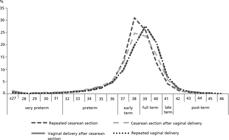Abstract
Objectives:
describe mothers, pregnancies and newborns’ characteristics according to the type of childbirth history and to analyze repeated cesarean section (RCS) and vaginal delivery after cesarean section (VBACS), in São Paulo State in 2012.
Methods:
data are from the Sistema de Informações sobre Nascidos Vivos (Live Birth Information Systems). To find the RCS’s group, the current type of childbirth equal to cesarean section was selected and from these all the previous cesareans. To identify the VBACS’s group all live birth with current vaginal delivery were selected and from these all previous cesareans. Mothers with a history of RCS and VBACS were analyzed according to the characteristics of the pregnancy, newborn and the childbirth hospital.
Results:
273,329 mothers of live birth with at least one previous child were studied. 43% of these were born of RCS and 7.4% of VBACS. Mothers who underwent RCS are older and higher educated and their newborns presented a lower incidence of low birth weight. Early term was the most frequent rating for gestational age born of RCS. Live births were of VBACS and had greater proportions of late term. The RCS was more common in hospitals not affiliated with the Sistema Único de Saúde (SUS) (Public Health System) (44.1%).
Conclusion:
the high RCS’s rates, especially in the private sector, highlight the necessity of improvements in childbirth care model in São Paulo.
Keywords:
Repeated cesarean section; Vaginal birth after cesarean; Cesarean section; Childbirth; Public Health System

 Thumbnail
Thumbnail
 Thumbnail
Thumbnail
 Thumbnail
Thumbnail


